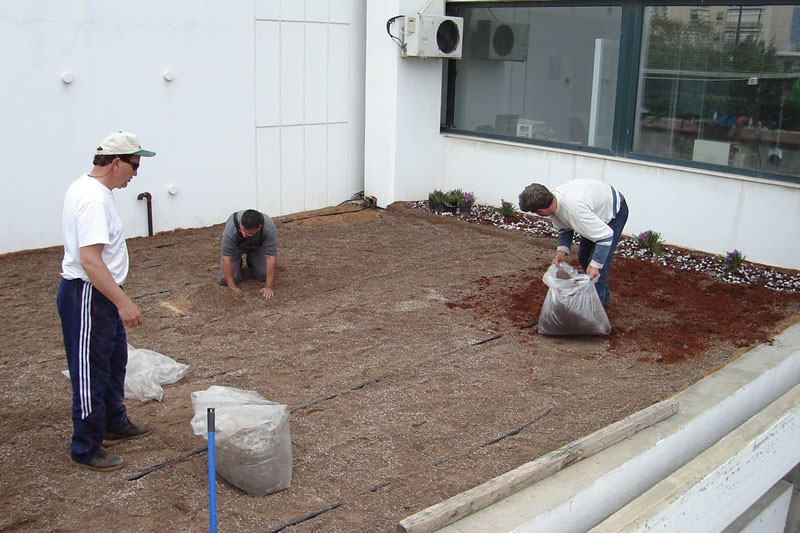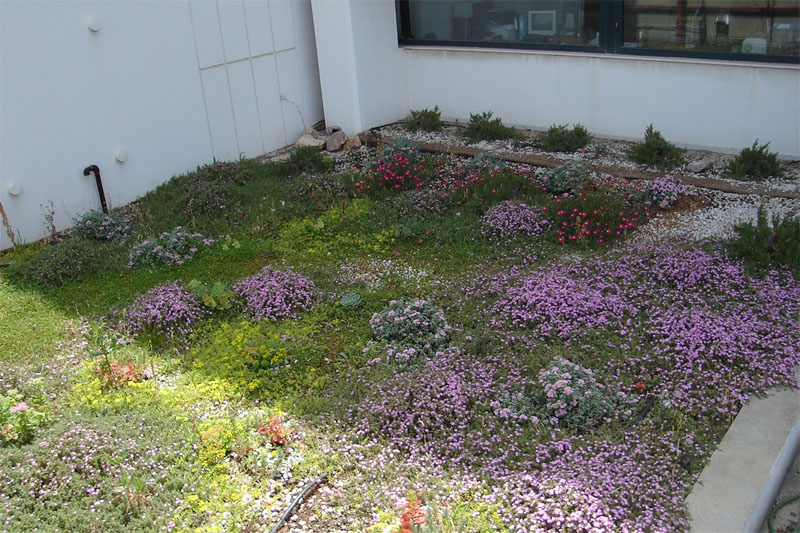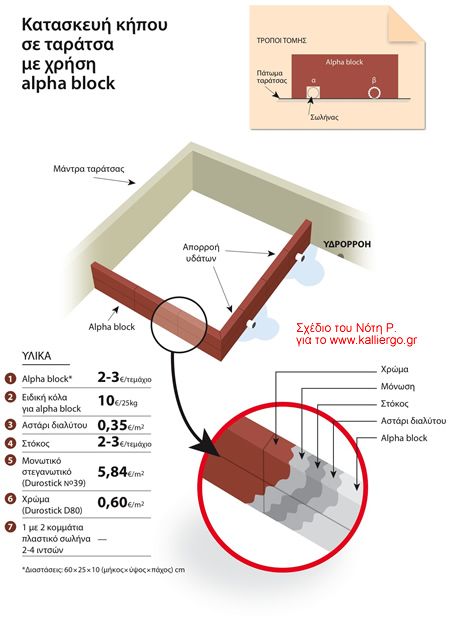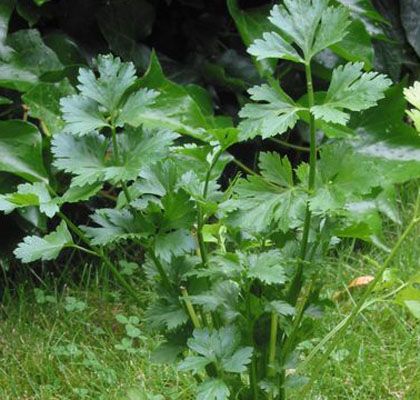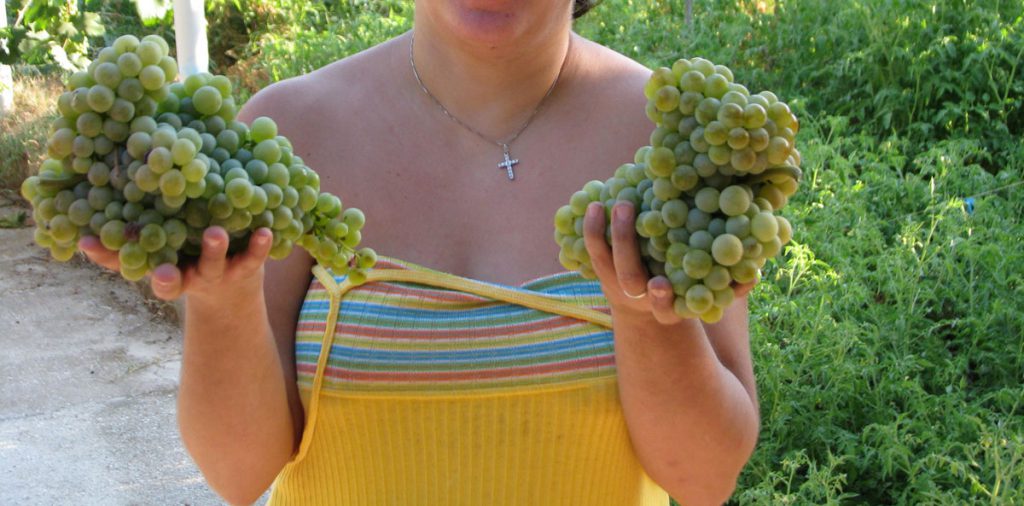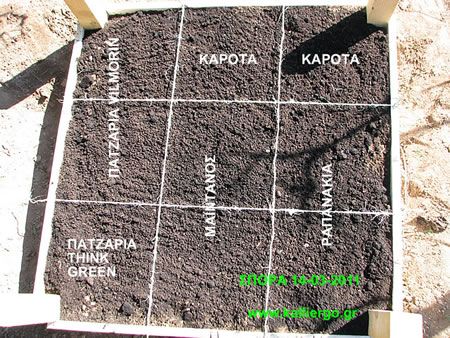You will find answers from experts to frequently asked questions about the construction of green roofs, vegetable gardens, types of green roofs, types of plants that can be planted, the many benefits of green roofs in the urban environment.
Can a rooftop or roof in the city be turned into a garden? The answer is definitely yes.
There are many solutions available, depending on what we want and what we can achieve.
Apart from the wants of every owner who wants to have a green roof, a garden in the city, there are parameters such as the structural capacity of the building, the permanent weight that the garden will add to the top of the building and the effect on the seismicity of the building, the cost.
So often the end result is a compromise between what we want to do and what we can, and can afford to do.
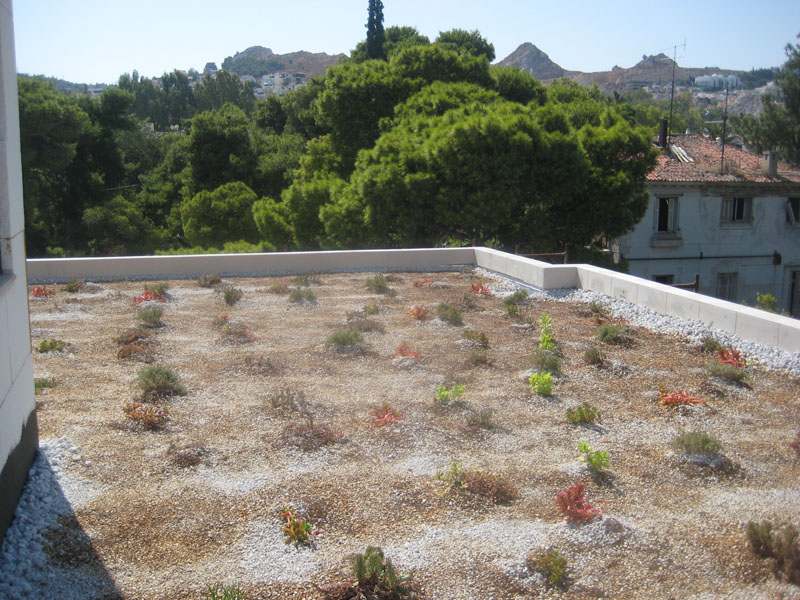
Types of green roofs
When we talk about green roofs and rooftop gardens, some people imagine lawns, others vegetables, herbs and shrubs and others gardens with all of the above but also trees.
None of the above is wrong, because there are rooftop gardens that fall into all 3 categories. Each type of green roof has its own name.
Extensive type of green roof
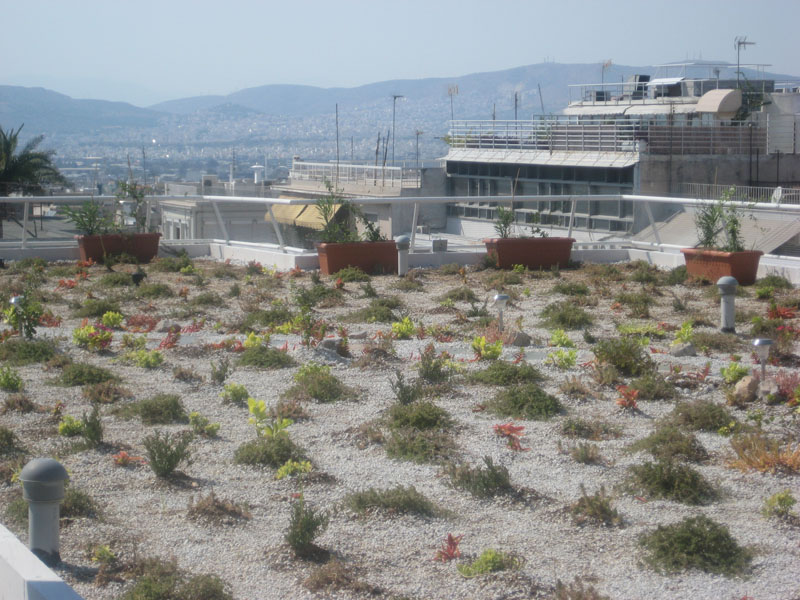
The extensive type of green roof is the most economical and ecological type.
The height (or depth) of the special substrate (soil) is between 2 and 15 cm.
On it can be planted grass, herbs, herbaceous ground cover plants.
Depending on the type of vegetation little or no watering is needed.
The static weight added (watered) to the construction is from 50 to 150 kg/sqm.
The landscape of the urban garden can be landscaped with paths and lighting for a perfect aesthetic effect.
Semi-extensive type of green roof
In this type of green roof, the height (or depth) of the special substrate (soil) can reach 15 to 50 cm.
Grasses, herbaceous ground cover plants, flowers, herbs, vegetables, shrubs can be planted.
The static weight added (watered) to the construction is from 120 to 200 kg/sqm.
The cost of construction is moderate.
It usually needs regular watering.
The landscape of the urban garden can be landscaped with paths, walls, raised beds and lighting for a perfect aesthetic effect.
Intensive green roof type
This is the most expensive type of green roof but also the type that offers the most possibilities as it can even support trees.
The height (or depth) of the special substrate (soil) is from 50 to 100 cm.
Lawns, herbaceous ground cover plants, flowers, vegetables, herbs, shrubs, trees can be planted.
Regular watering is required.
The static weight added (watered) to the structure is from 180 to 500 kg/sqm.
Suitable for buildings where there is provision in the design for such static loads or buildings with low height.
The landscape of the urban garden can be landscaped with paths, walls, raised beds and lighting for a perfect aesthetic effect.
Advantages and benefits of green roofs

The main reason why an individual will want to get a green roof, a rooftop garden is its own benefit.
The benefit will be aesthetic, productive, energy saving.
The criteria for a green roof on a public structure will be different and will be related to the contribution to the quality of the urban environment.
Green roofs and rooftop gardens in the city help to counteract the phenomenon of heat islands, reduced atmospheric humidity and reduce air pollution. Their owners therefore contribute to improving the general urban environment, in addition to their personal benefit.
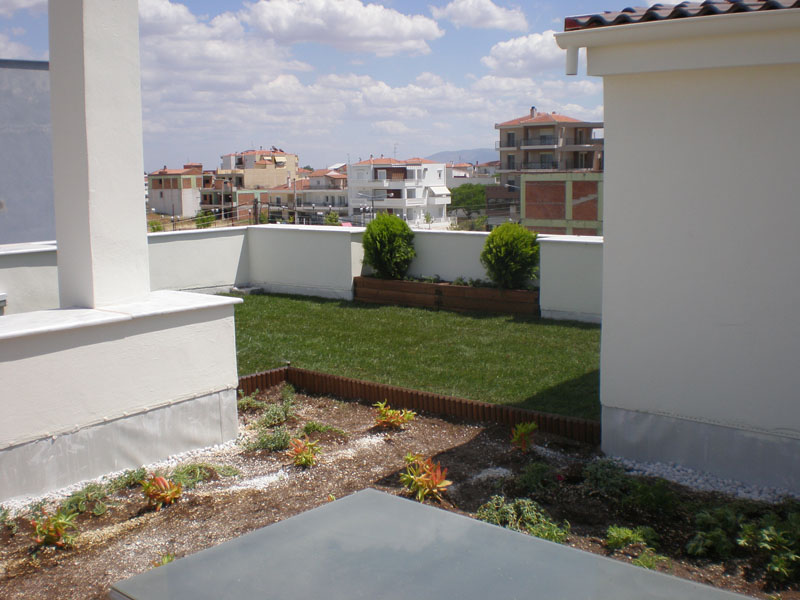
- Reducing the internal temperature of the building by up to 10 degrees Celsius
- Provides insulation. Reduction of heating and cooling costs of the building by up to 50%
- With a green roof the surface temperature of the roof is less than 35 degrees Celsius. The surface temperature of a conventional roof can reach 80 degrees Celsius! Plants on a planted roof absorb heat for their metabolic needs
- It reduces external noise by at least 10 decibel more than a conventional insulation. The multi-layered surface of the plants and the air trapped in the substrate and plants has a sound insulating effect. The green roof is an ideal solution for buildings located near strong noise sources (highways, factories, airports, etc.)
- The green roof filters and utilizes rainwater. A vegetated roof retains and filters 75% of the rainwater, providing flood protection to the city and also protecting the water from contamination. More than 75% of the rainwater from a roofless house goes directly into the sewage
- Reduction of electromagnetic radiation by 99.4%. Research conducted in Munich, in the city of Kassel, showed that: The penetration of electromagnetic radiation and microwaves was reduced by 99.4% in a building whose roof was planted!
- Fire protection. Research conducted in Berlin into the fire resistance of a green roof found that: They prevent fire from spreading, more than gravel roofs. This is due to water retention within the succulents used for planting. (Köhler, 2004)
- Significant cost reduction in building maintenance. Green vegetation protects the roof surface and waterproofing layer from: Rainfall, snow, hail, UV radiation, mechanical stresses. It doubles the life of the roof and waterproofing layer from 30 years to over 60 years. Zeroes the cost of re-sealing & maintenance of concrete
Conversion of roof & roof deck into a green roof
Seeking answers to practical and technical questions regarding the conversion of a rooftop to a green roof, I contacted a Greek company. Andreou Insulation ABETE, a company specializing in green roofs and insulation. I asked a series of questions that I believe cover most of our questions. My questions were answered by Mr. Andreou Anargyros a certified insulator by the NYSD and a civil engineer of Andreou Insulation ABETE.
Preparations have been completed on the roof and the substrate for plant growth is being placed.
The same roof in spring with the plants in bloom.
The same roof during winter.
Green Roof Construction – Questions & Answers
Does a green roof substitute for insulation? Does the roof-roof need to be insulated first and then the green roof?
Andreou Insulation ABETE: A green roof can replace the thermal and/or sound insulation of a roof insulation system. But in no way can it replace the waterproofing (the opposite) provided by a roof insulation system. It is therefore imperative that the creation of openings and damp-proofing be carried out before the application of a green roof.
What techniques exist for creating a green roof? What are the stages of application?
Andreou Insulation ABETE: There are several materials that meet the specifications to be used in an insulation prior to the application of the green roof (resistance to chemicals, fertilizers, tree roots, etc.).
Our company usually proposes a system with three layers of waterproofing: The first on the slab with flexthermo (flexible waterproofing system), the second again with flexthermo over therbobeto (the material used to create the slopes in the roof to drain the water of the roof garden) and finally the final waterproofing (the third), which is done either by laying a synthetic PVC membrane or a double, anti-root bituminous membrane.
Then it is proposed to install a drainage membrane capable of bearing the loads and, depending on the use and type of plants, the appropriate type of drainage system is selected from the study. It is also proposed to install a permeable soil retention sheet made of thermally reinforced polypropylene to prevent the transfer of residues to the drainage system.
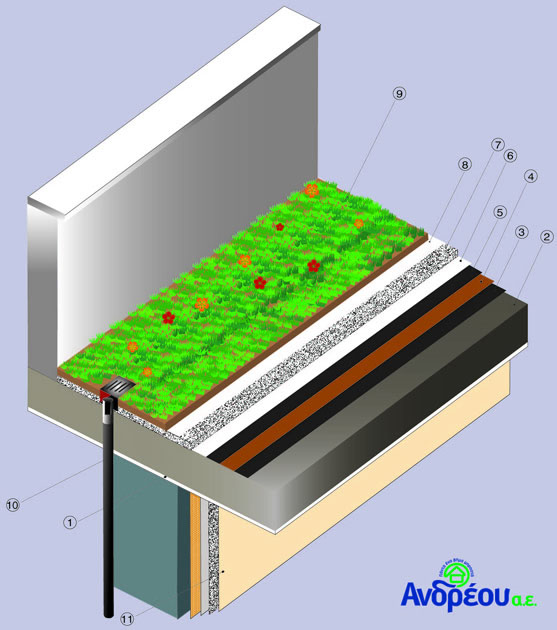
Green Roof section. Primer, 4. First layer of asphalt membrane, 5. Second layer of anti-root membrane, 6. Geotextile, 7. Mosaic, 8. Geotextile, 9. Special horticultural soil, 10. Special gutter piece, 11. External thermal protection system
What substrate (light soil) is used for green roofs?
Andreou Insulation ABETE: Depending on the type of green roof and always according to the study to be done by the agronomist supervising the project and the planting. As an indication, for the extensive type, which is the most common choice due to the reduced weight compared to other solutions, ready-made mix solutions are usually used. Organic compositions (e.g. sieved soil and organic compost,) with an optional supplement of river sand are always recommended. The goal is to lighten the soil loads while creating a subsoil for our plants that is rich in food, easily sheds moisture and heavy metals that can harm them, while not requiring chemical fertilizers that can wear away our waterproofing.
How is rainwater drainage from the green roof done?
Andreou Insulation ABETE: The water is led to the gutters that exist in the roof (if there are none created) by creating openings with therbobeto insulating lightweight concrete. Drainage in the event of a downpour is ensured by installing a permeable soil retention sheet made of thermally reinforced polypropylene. This prevents the transfer of soil residues to the drainage system.
Do I need to create slopes on the roof, roof deck and if so, how and with what material?
Andreou Insulation ABETE: Necessarily, slopes must be created in the roof. It is the way the water that will drain from the green roof (rain or irrigation) will go to the roof runoff. Proper slopes (usually at least 2%) are created with therbobeto insulating lightweight concrete.
Can one build a green roof on only part of one’s roof?
Andreou Insulation ABETE: Yes, it can, but the design must have been done from the beginning before the roof slopes are created.
Can a combination of the three types of green roof (extensive, semi-intensive, intensive) be done?
Andreou Insulation ABETE: A combination can be done. But the study must be done from the beginning so that the agronomist can combine the three solutions appropriately (compatible plants, flowers, trees, etc.)
Do you need permission from the planning authority to build a green roof?
Andreou Insulation ABETE: No, planning permission is not usually needed. But we do need to consult a civil engineer before construction, both for the structural adequacy of the building and for the height limits of the building (e.g. to plant trees).
How long does it take to build a green roof? What are the parameters that influence the time?
Andreou Insulation ABETE: The construction of a green roof takes approximately 30-45 days to complete. This duration can only be extended in case of extreme weather events (e.g. heat waves, prolonged periods of rain or frost, etc.)
How much does it cost to build a green roof?
Andreou Insulation ABETE.
What is the right season to build a green roof?
Andreou Insulation ABETE: It can be done at all times of the year without any problems in terms of sub-base (waterproofing and slopes). Planting is usually suggested by agronomists to be done at times when we do not have very high or very low temperatures.
How is the stability of the building checked?
Andreou Insulation ABETE: The structural design of the building is in the original construction plans submitted to the planning department. However, it is useful to have a reassessment of the situation by a civil engineer, especially for old buildings.
Is there a subsidy for the construction of a green roof?
Andreou Insulation ABETE: A green roof is normally subsidized by all government programs since it is essentially considered (and is) roof insulation. There is no special subsidy for green roofs. They are treated by the state as any other insulation.
Who chooses the plants to be planted?
Andrews Insulation ABETTE: The building owner always with the advice and study of an agronomist. If the owner does not have his own agronomist, Andreou Insulation ABETE can recommend an agronomist working with us.
Is there any monitoring of the green roof after its construction?
Andreou Insulation ABETE: The underpinning of the green roof (slopes and waterproofing) does not need any monitoring since it is usually covered by soil and plants and therefore hidden from the solar radiation that could damage it. The plants and flowers need monitoring and care just as you would with a simple garden.
Is there a guarantee? What does it cover and how much is it valid?
Andreou Insulation ABETE: The warranty of the green roof underpinning (waterproofing and slopes) ranges from 10 – 20 years depending on the materials ultimately chosen.
What can you recommend to someone who doesn’t want to build a full green roof, but islands-points-plants where they can plant flowers and vegetables?
Andreou Insulation ABETE: Anyone can make part of their roof a small garden. The process is no different, the space is demarcated and “built” to the height we want usually with ready-mixed concrete because we need good mechanical strength. But it can alternatively be built with alpha block or bricks etc. in cases where we have an extensive garden. Particular attention should be paid to the water drainage study from the point (island – flower bed etc.) and the structural study since we will now have point loads on the roof and careful selection of the point that will take the extra loads should be made. I think there is an article on this: “Build a vegetable garden on roof with Alpha blocks (YTONG blocks)”.
What types of plants can be planted on a green roof?
How can green roofs be planted on green roofs? Whatever the owner wants.
Restrictions on the choice of plants only exist in the extensive type, where the depth of the soil does not allow all options (e.g. trees or plants with a large root depth cannot be put in).
The other types of green roofs (semi-intensive and intensive) offer more plant and even tree choices. However, they usually apply to new homes that are designed and built to withstand green roofs.
The choice of green roof plants is made in collaboration between the agronomist and the owner.
Consideration is given to the prevailing climatic conditions, sunshine, shading from adjacent buildings, and the mood and time the owner can devote to his garden.
Typical types of plants used per type of green roof are:
Extensive type
Typical types of gardens
Sedum sp. and herbaceous plants
Sedum sp. sedum sp and herbaceous plants
Sedum sedum-grasses and herbaceous plants
Mediterranean ground cover species
Aromatic plants
Semi-intensive type
All plant types are supported by the extensive type and in addition
Grasses – perennial herbaceous plants
Local herbaceous – shrubby vegetation
Shrubby vegetation with above-ground growth up to 60 cm
Intensive type
In the intensive type, the agricultural planner can choose from a much greater variety of plant types, including small or medium-growing trees.
The owner must understand that a green roof is in essence a normal garden that will need care like a normal garden. At the same time, apart from insulation and temperature reduction, it will provide all the joys and satisfactions that a garden offers!
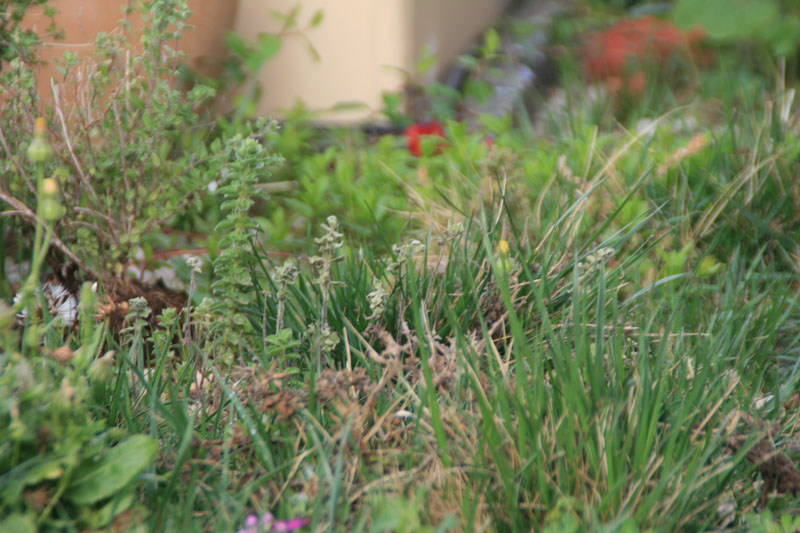
How can I build a green roof? More information

For more information on how you can turn your terrace or roof into a green roof, you can contact the Greek company Andreou Insulation ABETE.
The company specializes exclusively in insulation and has extensive experience in the construction of green roofs. It has several crews with certified insulators. It has stores in Kifisia (Athens) and Evia (Chalkida).
Andreou Insulation ABETE has service and sales departments for insulation materials and equipment.
It specializes in roof insulation, thermal insulation, green roofs, roof-roof insulation, passive houses, foundation insulation, building upgrades, thermographic inspections, damp-proof floors, damp-proof walls, industrial floors.
Tags: ANDREOU SA • CITY • GREEN ROOFS • ROOF GARDEN


